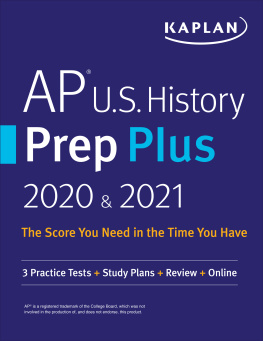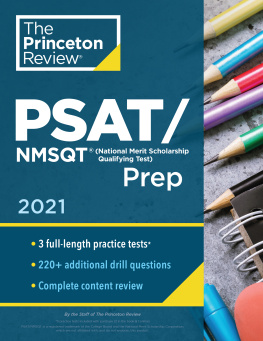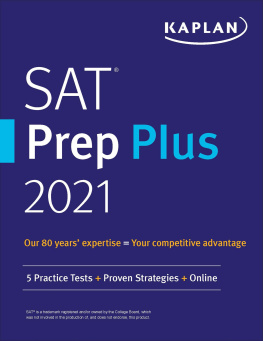

PSAT/
NMSQT
Prep
20222023
PSAT/NMSQT is a registered trademark of the College Board and the National Merit Scholarship Corporation, which were not involved in the production of, and do not endorse, this product.
Editors-in-Chief
M. Dominic Eggert; Alexandra Strelka, MA
Contributing Editors
Dr. Brandon Deason, MD; Katy Haynicz-Smith, MA; J. Scott Mullison; Kathryn Sollenberger, MEd; Glen Stohr, JD
Special thanks to our faculty authors and reviewers
Michael Cook; Christopher Cosci; Boris Dvorkin; John Evans; Chason Goldschmitz; Emily Graves; Jonathan Habermacher; Jack Hayes; Jo LAbbate; Bird Marathe; Karen McCulloch; Melissa McLaughlin; Gail Rivers; Anne Marie Salloum; Jason Selzer; Gordon Spector; Caroline Sykes; Bob Verini, MFA; Bonnie Wang; and Ethan Weber
Additional special thanks to
Laura Aitcheson; Deborah Becak; Isaac Botier; Brian Carlidge; Mark Feery; Paula L. Fleming, MA, MBA; Joanna Graham; Rebekah Hawthorne; Ryan Henry; Rebecca Knauer; Abnia Loriston, MEd; Camellia Mukherjee; Kristin Murner, PhD; Aishwarya Pillai; Michael Wolff; Amy Zarkos; and the countless others who made this project possible
PSAT/NMSQT is a registered trademark of the College Board and the National Merit Scholarship Corporation, which were not involved in the production of, and do not endorse, this product.
This publication is designed to provide accurate information in regard to the subject matter covered as of its publication date, with the understanding that knowledge and best practice constantly evolve. The publisher is not engaged in rendering medical, legal, accounting, or other professional service. If medical or legal advice or other expert assistance is required, the services of a competent professional should be sought. This publication is not intended for use in clinical practice or the delivery of medical care. To the fullest extent of the law, neither the publisher nor the editors assume any liability for any injury and/or damage to persons or property arising out of or related to any use of the material contained in this book.
2022 by Kaplan, Inc.
Published by Kaplan Publishing, a division of Kaplan, Inc.
750 Third Avenue
New York, NY 10017
All rights reserved. The text of this publication, or any part thereof, may not be reproduced in any manner whatsoever without written permission from the publisher.
10 9 8 7 6 5 4 3 2 1
ISBN-13: 978-1-5062-8217-6
Kaplan Publishing print books are available at special quantity discounts to use for sales promotions, employee premiums, or educational purposes. For more information or to purchase books, please call the Simon & Schuster Special Sales department at 866-506-1949.
TABLE OF CONTENTS
This book is designed to help you score high on any pencil and paper PSAT exam into the spring of 2023. We understand that your time is limited and that this book is hefty, but nobody expects you to read every word. Nor do we expect you to go in order. If you need more work on the Writing and Language section than on Math, for example, then feel free to skip over the math chapters. The most efficient way to use this book is to spend the most time on those areas that give you trouble, starting with those that are tested most often. If youre not sure, use the pretests we provide in each chapter to figure out how much time to spend on that material.
Chapter Organization
Most chapters start with a section called How Much Do You Know? that helps you get a sense of how comfortable you already are with the material in the chapter. Answers and explanations follow immediately in the Check Your Work section. Each lesson in a chapter starts with a question typical of the way the PSAT tests a given topic and ends with a set of practice questions called Try on Your Own. There is yet another practice set at the end of each chapter called How Much Have You Learned? to reinforce the concepts explained in the chapter. Answers and Explanations for the Try on Your Own and How Much Have You Learned? sections are found at the end of each chapter for easy reference.
Practice Tests
There are two practice tests at the back of this book, both with full answer explanations. We recommend that you spread them out: take one when you first start to study for the PSAT and the second about a week before your test date.
Youre Already on Your Way
You already have many of the skills youll need to excel on the PSAT, but youll need to adapt those skills to the structure of the exam. For example, you already know how to read. Youve probably also created outlines for essays youve written in school. This book will teach you to adapt to the PSAT by outlining a passage as you read it. It will also teach you to adapt your math skills to solve questions more efficiently, locate grammar issues quickly and confidently, and prioritize the topics that get tested the most.
SmartPoints
Different topics are worth different numbers of points on the PSAT because they show up more or less frequently in questions. By studying the information released by the College Board, Kaplan has been able to determine how often certain topics are likely to show up on the PSAT, and therefore how many points these topics are worth on test day. If you master a given topic, you can expect to earn the corresponding number of SmartPoints on test day.
We have used a 600-point scale for SmartPoints because thats the number of points you can earn within the Math and Verbal subscores: the PSAT scoring scale is 160760, so there are 760 160 = 600 points to be earned within each major section of the test. The breakdown of SmartPoints for Math, Reading, and Writing and Language are summarized in the following tables. Keep in mind that these values are approximate because testing administrations differ.
| Math |
|---|
| SmartPoints Category | # of Points | Subcategories |
|---|
| Linear Equations | 110 | Linear equations, linear graphs, word problems |
| Functions | 105 | Functions, graphs of functions, functions in word problems |
| Ratios, Proportions, and Percents | 80 | Setting up a proportion to solve for an unknown, unit conversion, calculating percent and percent change |
| Quadratics | 60 | Quadratic equations, parabolas, modeling data, mixed systems of equations |
| Statistics and Probability | 60 | Descriptive statistics, probability, tables and charts, data samples |
| Systems of Linear Equations | 45 | Systems of equations, number of possible solutions |
| Geometry | 35 | Triangles, circles, 3-dimensional figures |
| Inequalities | 35 | Inequalities, graphical representations of inequalities |
| Scatterplots | 35 | Scatterplots, lines of best fit, modeling data |
| Exponents, Radicals, Polynomials, and Rational Expressions | 25 | Exponents, radicals, polynomial operations, graphs of polynomials, modeling growth and decay, rational expressions/equations |
| Imaginary Numbers | 5 | Adding, subtracting, multiplying, and dividing complex numbers |
| Trigonometry | 5 | Sine, cosine, tangent |
| TOTAL | 600 |
Next page
















